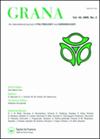Assessment of pollen and honey diet of Tetragonisca angustula fiebrigi Schwarz in the Chaco dry forest by using pollen analysis
IF 1
4区 生物学
Q4 PLANT SCIENCES
引用次数: 2
Abstract
Abstract Pollen and honey resources composing the diet of Tetragonisca angustula fiebrigi Schwarz were assessed using pollen analysis of wild colonies sampled in two kinds of native dry forests of the Chaco region. Different measurements: direct pollen count, relative volume, diversity and evenness indices, value of importance of species (SI), and index of relative importance (IRI) were compared. The IRI identified the most important pollen resources as Prosopis (IRI = 1619), Schinopsis type (IRI = 1578), Trithrinax schizophylla (IRI = 972) and Capparicordis/Sarcotoxicum (IRI = 587), and according to SI the honey resources were Schinopsis type (SI = 117.41), Maytenus type (SI = 101.89), Prosopis (SI = 86.47) and Ziziphus mistol (SI = 50.93). The absolute pollen analysis of honey revealed that all samples were rich in pollen grains. Floral resources were most homogeneously foraged during spring and summer when a high number of flowerings were available and the highest temperatures were recorded. These optimal conditions for bee foraging activity also allowed for the highest diversity indices in these seasons. However, heterogeneous foraging and low diversity were detected during winter and autumn. Most pollen and honey resources belonged to generalised small flowers of diverse plant lineages. The IRI was more comprehensive to identify the most important pollen resources than the commonly used direct pollen count, as it also includes relative volume and frequency of occurrence, and SI was the most thorough for studying the honey resources. This study provides helpful information for sustainable meliponiculture and forest conservation.用花粉分析方法评价查科干旱林四家蝇的花粉和蜂蜜食性
摘要利用对查科地区两种原生干林中野生群落的花粉分析,评价了番荔枝(Tetragonica angustula fiebrigi Schwarz)日粮中的花粉和蜂蜜资源。比较了不同的测量方法:直接花粉计数、相对体积、多样性和均匀度指数、物种重要性值(SI)和相对重要性指数(IRI)。IRI鉴定出最重要的花粉资源为Prosopis(IRI=1619)、Schinopsis型(IRI=1578)、Trithrinax spliphylla(IRI=972)和Capparicordis/Sarcotoxicum(IRI=587),Prosopis(SI=86.47)和Ziziphus mistol(SI=50.93)。蜂蜜的绝对花粉分析表明,所有样品都富含花粉粒。花卉资源在春季和夏季觅食最为均匀,当时有大量的花卉可供选择,气温最高。这些蜜蜂觅食活动的最佳条件也使这些季节的多样性指数最高。然而,在冬季和秋季发现了异质性觅食和低多样性。大多数花粉和蜂蜜资源属于不同植物谱系的普通小花。IRI比常用的直接花粉计数更全面地确定了最重要的花粉资源,因为它还包括相对体积和出现频率,而SI是研究蜂蜜资源最彻底的。本研究为可持续的养蜂和森林保护提供了有益的信息。
本文章由计算机程序翻译,如有差异,请以英文原文为准。
求助全文
约1分钟内获得全文
求助全文
来源期刊

Grana
生物-植物科学
CiteScore
2.10
自引率
11.10%
发文量
23
审稿时长
>12 weeks
期刊介绍:
Grana is an international journal of palynology and aerobiology. It is published under the auspices of the Scandinavian Palynological Collegium (CPS) in affiliation with the International Association for Aerobiology (IAA). Grana publishes original papers, mainly on ontogony (morphology, and ultrastructure of pollen grains and spores of Eucaryota and their importance for plant taxonomy, ecology, phytogeography, paleobotany, etc.) and aerobiology. All submitted manuscripts are subject to initial appraisal by the Editors, and, if found suitable for further consideration, to peer review by independent, anonymous expert referees. All peer review is single blind and submission is online via ScholarOne Manuscripts.
 求助内容:
求助内容: 应助结果提醒方式:
应助结果提醒方式:


